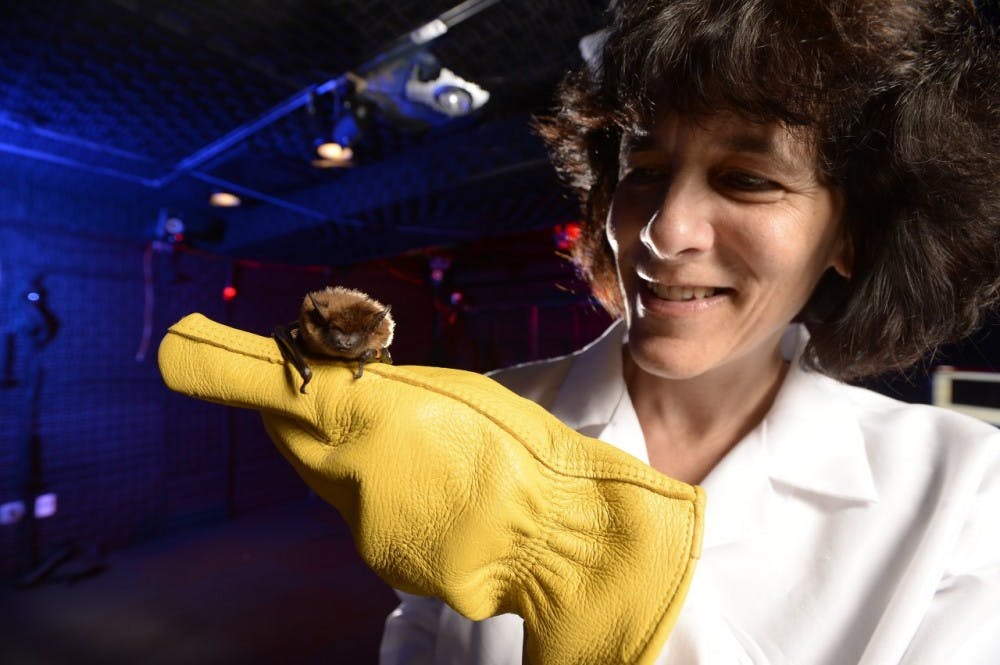Cynthia Moss is a Hopkins professor in the Department of Psychological and Brain Sciences, with joint appointments in Neuroscience and Mechanical Engineering.
Her research is centralized in a place fondly known as the “Bat Lab,” where she aims to better understand how bat brains interpret the world around them using echolocation.
In high school, Moss’s main interests were in the humanities. When she was a teenager, her family briefly lived in Italy and, after moving back to the United States, took in a French exchange student.
These experiences encouraged Moss to study abroad herself. When she graduated high school early, she applied to a foreign-exchange program that didn’t allow her to choose where she went.
She ended up being sent to Sweden, where she began to volunteer in homes and schools for kids with developmental or sensory conditions. This quickly became an interest of hers, and when the time came, she ended up going to University of Massachusetts, Amherst, where she delved into research that related to the interests she developed in Sweden.
While at college, she worked in an incredibly dysfunctional home for individuals of all ages with developmental delays and described the terrible conditions there.
“It was a really, really horrible place,” Moss said in an interview with The News-Letter. “There was no real attention to individual needs and the living conditions were just incredibly grim.”
At the end of her time there, at age 19, Moss began to feel burned out and worked as a waitress. Ultimately, however, she remained interested in how information is gathered and processed by the nervous system. Studying the sensory systems of humans and frogs in her undergraduate and graduate careers eventually led her to echolocation in bats.
Moss explained that her work is broadly about how animals use information they get from their surroundings.
“We study how animals use sensory information to guide behavior, and we’re specifically interested in spatially guided behavior,” she said.
Moss’s lab studies this from various angles using information from multiple senses and relating it to flight behavior. They observe how senses other than hearing, like smell or vision, can help guide bats towards ripe fruits, insects, or other objects of interest.
Moss explained that bats change the sound of their calls according to the object they are seeking and also the information they receive back. When a bat zeroes in on an object, it increases the rate of its calls.
Moss described how this can be explained, once you consider the speed of sound and how it is translated into information about distance.
“If a bat is far away and makes a call two milliseconds long, at that distance the echo will arrive after the call is completed,” Moss said. “But if you have the same two-millisecond call when the bat is close to an object, there may be overlap between the call and the echo. To avoid that the bat needs to shorten the call.”
With several objects around, Moss and her team can make inferences about what a bat might be focusing on based on its calls.
The Bat Lab studies four different species of bats, but the one they study the most is a half-an-ounce, Baltimore local: the big brown bat. The lab takes them from the wild and records them performing behaviors like maneuvering around objects, chasing objects and even predicting where an insect is going to be in order to move in for the catch.
For undergraduates interested in Neuroscience or Behavioral Biology, Moss recommends looking through the faculty profiles of the Psychological and Brain Sciences Department at the Homewood Campus or various departments at the medical school.
However, Moss also stressed that students shouldn’t limit themselves to a single department as many professors have joint appointments.
“You can be surprised,” she said. “There may be research going along in engineering, if you’re a Biology or Neuroscience student, that might capture your interest. Scour the faculty research websites, and then reach out to those who are doing work that interests you.”





